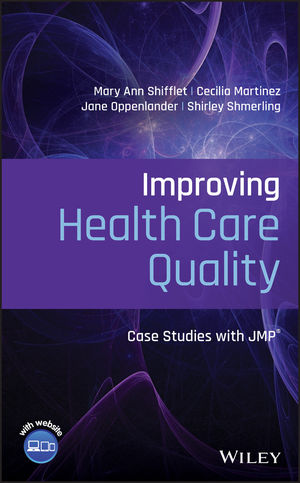Mary Ann Shifflet & Others – Improving Health Care Quality: Case Studies with JMP
Mary Ann Shifflet & Others – Improving Health Care Quality: Case Studies with JMP
-
DESCRIPTION
Learn how to improve the quality of health care offered by your institution using data you already have
Improving Health Care Quality: Case Studies with JMP® teaches readers how to systematically identify problems, collect and interpret data, and solve issues in the real world. Relying on JMP® software, the authors walk readers through the process of applying quality improvement techniques to real-life health care problems.
The case studies provided in the book vary significantly and provide a wide-ranging view of the application of quality improvement techniques in the health care field. Studies regarding length of stay of diabetes patients to benchmarking the costs of hip replacement all serve to illuminate and explain the underlying concepts of statistical analysis.
The authors break each case study down into several sections, including:
- Background and Task
- Data an…
READ MORERELATED RESOURCES
Instructor
View Instructor Companion Site
Student
View Student Companion Site
ABOUT THE AUTHOR
Mary Ann Shifflet is an Assistant Professor in the Romain College of Business at the University of Southern Indiana in Evansville, Indiana. Dr. Shifflet received her undergraduate degree in Statistics from Oneonta State in New York and Master’s Degree and PhD in Statistics from Virginia Tech in Blacksburg, Virginia. Prior to joining USI she worked in industry as a statistical consultant for General Foods, Merck Pharmaceuticals and for Spencer Research.
Cecilia Martinez is an Associate Professor of Engineering and Management in the Reh School of Business at Clarkson University. She received her Ph.D. in Engineering Management from Texas Tech University and her M.S. in Manufacturing Systems and B.S. in Industrial Engineering from Monterrey Tech. She has taught courses in Quality Management and Lean Enterprise, Operations and Supply Chain Management and Interdisciplinary Engineering Design.
Jane Oppenlander is an Assistant Professor in the Reh School of Business and The Bioethics Program at Clarkson University where she teaches statistics in both classroom and online formats. She received her Ph.D. in Administrative and Engineering Systems from Union College and an M.S. in statistics, a B.A. in mathematics, and a B.S. in education, all from the University of Vermont. Jane is a certified Six Sigma Master Black Belt.
Shirley Shmerling is a full-time faculty of the Isenberg School of Management at the University of Massachusetts. She teaches Operations and Information Management courses, has several publications in journals such as Physician Leadership Journal and is a board member at the American College of Healthcare Trustees. Shirley holds a B.Sc. (Computer Science) and M.Sc. (Operations Research) from the Israel Institute of Technology and a Ph.D. in Management Science from the University of Massachusetts.
PERMISSIONS
Request permission to reuse content from this site
TABLE OF CONTENTS
Foreword xv
Preface xvii
Acknowledgments xix
Acronyms and Synonyms xxi
About the Companion Website xxiii
1 Introduction 1
1.1 Key Concepts 1
1.2 Quality Improvement in Healthcare 1
1.3 Understanding Variability: The Key to QI 2
1.4 Quality Improvement Frameworks 3
1.4.1 Define–Measure–Analyze–Improve–Control (DMAIC) 4
1.4.2 Plan–Do–Check–Act (PDCA) 4
1.4.3 Choosing a Framework 5
1.5 Statistical Tools for Quality Improvement 6
1.5.1 Data Visualization 8
1.5.2 Subgrouping Data 8
1.5.3 Control Charts 9
1.5.4 The Importance of Assumptions 10
1.6 Using this Casebook 11
1.7 Summary 12
1.7.1 Exercises 13
1.7.2 Discussion Questions 14
References 14
2 Improving Patient Satisfaction 17
2.1 Key Concepts 17
2.2 DMAIC 17
2.3 PDCA 17
2.4 Background 17
2.5 The Task 18
2.6 The Data: ComplaintData.xlsx and PatientFeedback.jmp 18
2.7 Data Management 19
2.8 Analysis 20
2.8.1 Complaint Data 20
2.8.2 Patient Satisfaction Data 21
2.9 Summary 26
2.9.1 Statistical Insights 26
2.9.2 Implications and Next Steps 27
2.9.3 Summary of Tools and JMP Features 27
2.9.4 Exercises 27
2.9.5 Discussion Questions 28
Reference 29
3 Length of Stay and Readmission for Hospitalized Diabetes Patients 31
3.1 Key Concepts 31
3.2 DMAIC 31
3.3 PDCA 31
3.4 Background 31
3.5 The Task 32
3.6 The Data: HospitalReadmission.jmp 32
3.7 Data Management 32
3.8 Analysis 32
3.9 Summary 39
3.9.1 Statistical Insights 39
3.9.2 Implications and Next Steps 39
3.9.3 Summary of Tools and JMP Features 40
3.9.4 Exercises 40
3.9.5 Discussion Questions 41
4 Identify and Communicate Opportunities for Reducing Hospital Length of Stay Using JMP® Dashboards 43
4.1 Key Concepts 43
4.2 DMAIC 43
4.3 PDCA 43
4.4 Background 43
4.5 The Task 44
4.6 The Data: HospitalReadmission.jmp 44
4.7 Data Management 44
4.8 Analysis 44
4.8.1 Creating Dashboards with Combine Windows 44
4.8.2 Creating Dashboards with Dashboard Builder 45
4.8.3 Saving and Sharing JMP Dashboards 48
4.9 Summary 48
4.9.1 Statistical Insights 48
4.9.2 Implications and Next Steps 52
4.9.3 Summary of Tools and JMP Features 52
4.9.4 Exercises 53
4.9.5 Discussion Questions 53
References 53
5 Variability in the Cost of Hip Replacement 55
5.1 Key Concepts 55
5.2 DMAIC 55
5.3 PDCA 55
5.4 Background 55
5.5 The Task 56
5.6 The Data: SouthernTier_HipReplacement.csv 56
5.7 Data Management 56
5.7.1 Initial Data Review 57
5.7.2 Adjusting JMP Column Properties 58
5.7.3 Deleting Unneeded Columns 59
5.7.4 Shortening Character Columns 60
5.8 Analysis 61
5.8.1 Descriptive Analysis 62
5.8.2 Assessing Variability 63
5.9 Summary 67
5.9.1 Statistical Insights 67
5.9.2 Implications and Next Steps 67
5.9.3 Summary of Tools and JMP Features 68
5.9.4 Exercises 68
5.9.5 Discussion Questions 69
References 70
6 Benchmarking the Cost of Hip Replacement 71
6.1 Key Concepts 71
6.2 DMAIC 71
6.3 PDCA 71
6.4 Background 71
6.5 The Task 72
6.6 The Data: HipNYSPARCS_SouthernTier.jmp 72
6.7 Data Management 72
6.8 Analysis 73
6.8.1 Descriptive Analysis 73
6.8.2 Statistical Test of Hypothesis 73
6.8.3 Confidence Interval for Mean Total Cost 75
6.9 Summary 75
6.9.1 Statistical Insights 75
6.9.2 Implications and Next Steps 76
6.9.3 Summary of Tools and JMP Features 76
6.9.4 Exercises 76
6.9.5 Discussion Questions 77
References 78
7 Nursing Survey 79
7.1 Key Concepts 79
7.2 DMAIC 79
7.3 PDCA 79
7.4 Background 79
7.5 The Task 80
7.6 The Data: NursingResearch_Survey_Responses.jmp 80
7.7 Data Management 81
7.7.1 Initial Data Review 81
7.7.2 Recoding the Primary Role Column 83
7.8 Analysis 85
7.8.1 Descriptive Analysis 85
7.8.2 One-Sample Test of Proportion 87
7.8.3 Test for Difference of Two Proportions 88
7.9 Summary 90
7.9.1 Statistical Insights 90
7.9.2 Implications and Next Steps 90
7.9.3 Summary of Tools and JMP Features 91
7.9.4 Exercises 91
7.9.5 Discussion Questions 92
References 93
8 Determining the Sample Size for a Nursing Research Study 95
8.1 Key Concepts 95
8.2 DMAIC 95
8.3 PDCA 95
8.4 Background 95
8.5 The Task 96
8.6 The Data 96
8.7 Study Design and Data Collection Methodology 96
8.8 Analysis 97
8.8.1 Analysis Plan 97
8.8.2 The Basics of Sample Size Determination 98
8.8.3 Sample Size Determination for the Bee Sting Study 99
8.9 Summary 101
8.9.1 Statistical Insights 101
8.9.2 Implications and Next Steps 102
8.9.3 Summary of Tools and JMP Features 103
8.9.4 Exercises 104
8.9.5 Discussion Questions 104
References 105
9 Mapping California Ambulance Diversion 107
9.1 Key Concepts 107
9.2 DMAIC 107
9.3 PDCA 107
9.4 Background 107
9.5 The Task 108
9.6 The Data: ED_ambulance_diversion_trend.xlsx and CA_healthcare_facility_locations.xlsx 108
9.7 Data Management 108
9.7.1 Merging the Data Tables 109
9.7.2 Reviewing the Merged File 109
9.7.3 Extracting General Acute Care Hospital Data 112
9.8 Analysis 112
9.8.1 Descriptive Analysis 112
9.8.2 Geographic Distribution of Total Diversion Hours 113
9.9 Summary 116
9.9.1 Statistical Insights 116
9.9.2 Implications and Next Steps 116
9.9.3 Summary of Tools and JMP Features 117
9.9.4 Exercises 117
9.9.5 Discussion Questions 118
References 118
10 Monitoring Ambulance Diversion Hours 119
10.1 Key Concepts 119
10.2 DMAIC 119
10.3 PDCA 119
10.4 Background 119
10.5 The Task 120
10.6 The Data: CedarsSinai_Diversion_Hours.jmp 120
10.7 Data Management 121
10.8 Analysis 121
10.8.1 Descriptive Analysis 121
10.8.2 Control Chart Basics 122
10.8.3 Ambulance Diversion Process 123
10.8.4 Setting the Control Limits 123
10.8.5 Monitoring Ambulance Diversion with IR Charts 126
10.9 Summary 130
10.9.1 Statistical Insights 130
10.9.2 Implications and Next Steps 130
10.9.3 Summary of Tools and JMP Features 131
10.9.4 Exercises 131
10.9.5 Discussion Questions 132
References 132
11 Ambulatory Surgery Start Times 133
11.1 Key Concepts 133
11.2 DMAIC 133
11.3 PDCA 133
11.4 Background 133
11.5 The Task 134
11.6 The Data: ASU.jmp 134
11.7 Data Management 134
11.8 Analysis 135
11.8.1 Case 1 Analysis 138
11.8.2 Case 2 Analysis 140
11.9 Summary 141
11.9.1 Statistical Insights 141
11.9.2 Implications and Next Steps 143
11.9.3 Summary of Tools and JMP Features 144
11.9.4 Exercises 144
11.9.5 Discussion Questions 145
Reference 145
12 Pre-Op TJR Process Improvement – Part 1 147
12.1 Key Concepts 147
12.2 DMAIC 147
12.3 PDCA 147
12.4 Background 147
12.5 The Task 148
12.6 The Data: TJR.xlsx 148
12.7 Data Management 150
12.8 Analysis 153
12.9 Summary 159
12.9.1 Statistical Insights 159
12.9.2 Implications and Next Steps 161
12.9.3 Summary of Tools and JMP Features 161
12.9.4 Exercises 161
12.9.5 Discussion Questions 162
Reference 163
13 Pre-Op TJR Process Improvement – Part 2 165
13.1 Key Concepts 165
13.2 DMAIC 165
13.3 PDCA 165
13.4 Background 165
13.5 The Task 166
13.6 The Data: TJR.jmp 166
13.7 Data Management 166
13.8 Analysis 167
13.9 Summary 173
13.9.1 Statistical Insights 173
13.9.2 Implications and Next Steps 174
13.9.3 Summary of Tools and JMP Features 174
13.9.4 Exercises 174
13.9.5 Discussion Questions 175
References 175
14 Pre-Op TJR Process Improvement – Part 3 177
14.1 Key Concepts 177
14.2 DMAIC 177
14.3 PDCA 177
14.4 Background 177
14.5 The Task 178
14.6 The Data: TJR.jmp 178
14.7 Data Management 179
14.8 Analysis 179
14.9 Summary 187
14.9.1 Statistical Insights 187
14.9.2 Implications and Next Steps 188
14.9.3 Summary of Tools and JMP Features 190
14.9.4 Exercises 190
14.9.5 Discussion Questions 191
References 191
Index 193
Sale Page : https://www.wiley.com/en-be/Improving+Health+Care+Quality%3A+Case+Studies+with+JMP-p-9781119604679
Shipping method
– After making a purchase, you will see a View your order link to the Downloads page. Here you can download all the files related to your order.
– In case the link is broken for any reason, please contact us and we will resend a new download link.
– If you can’t find the download link, please don’t worry about it. This course is usually available and shipped within one day
– The course you purchased will have lifetime access
– Our support staff is the best by far! Please contact us at email: [email protected] and we will be happy to help!










